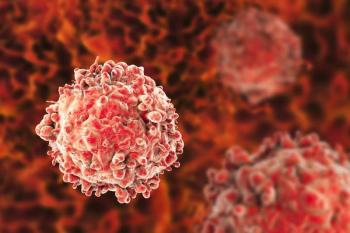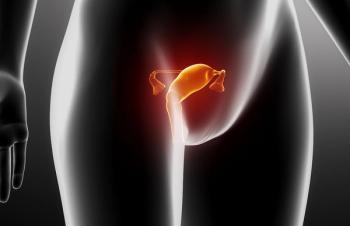
Recommended Phase 2 Dose of Selinexor Plus Pomalidomide and Dexamethasone Effective for Relapsed/Refractory Multiple Myeloma
The treatment combination of selinexor plus pomalidomide and dexamethasone at the recommended phase 2 dose produced more durable and deep responses than the lesser selinexor dose for relapsed or refractory multiple myeloma.
Treatment with 60 mg of selinexor (Xpovio) plus pomalidomide (Pomalyst) and dexamethasone (XPd-60) produced stronger and deeper responses than the 40 mg dose regimen (XPd-40) for patients with relapsed/refractory multiple myeloma who were previously treated with an anti-CD38 monoclonal antibody, according to results from the multi-arm phase 1b/2 STOMP study (NCT02343042) presented at the
In the XPd-60 arm, the overall response rate (ORR) was 65.0% compared with 48.1% in the XPd-40 arm. Responses were notably deeper in the XPd-60 arm, with a complete response (CR)/stringent CR rate of 5.0% and a very good partial response rate of 25.0% compared with 3.7% and 7.4% in the XPd-40 arm, respectively. The clinical benefit rate was 75.0% and 70.4% in the XPd-60 and XPd-40 arms, respectively.
“There is a need for effective and well-tolerated therapies to treat multiple myeloma that has progressed after treatment with [anti-CD38 monoclonal antibodies], as well as with lenalidomide (Revlimid) and bortezomib (Velcade),” poster presenter, Darrell White, MD, a hematologist; professor of medicine in the Division of Hematology, Department of Medicine; and the senior associate dean at the Dalhousie University and Queen Elizabeth II Health Sciences Centre, Halifax, NS, Canada, said in his presentation of the data.
Eligible patients had relapsed/refractory multiple myeloma and were previously treated with at least 2 cycles of lenalidomide and a proteasome inhibitor. Although prior pomalidomide (Pomalyst) treatment was allowed, patients who had pomalidomide-refractory multiple myeloma were only eligible for the dose escalation phase.
The primary end points of the trial included determining the maximum tolerated dose, recommended phase 2 dose, and ORR. Secondary end points included safety and tolerability, progression-free survival (PFS), and overall survival (OS).
The XPd-60 arm featured the recommended phase 2 dose, was 60 mg of selinexor once weekly combined with 4 mg of pomalidomide once daily from days 1 to 21 and 40 mg of dexamethasone once weekly. The XPd-40 arm received 40 mg of selinexor with the same pomalidomide/dexamethasone backbone.
At the October 8, 2021, cutoff date, 27 patients were enrolled in the XPd-40 arm and 20 were included in the XPd-60 arm. The median age was 67.0 years (range, 48-78). Additionally, 63% of patients were male, and 51.9% had an ECOG performance status of 1. For the XPd-60 arm, patients had a median age of 65.5 years (range, 37-85). Sixty-five percent of patients were female and 70% had an ECOG performance status of 1.
All patients underwent prior therapy with lenalidomide and a proteasome inhibitor. Moreover, 59.3% of patients in the XPd-40 arm received prior therapy with daratumumab compared with 30.0% of patients in the XPd-60 arm.
The median PFS was 10.9 months (95% CI, 7.6–not evaluable [NE]) in the XPd-60 arm and was NE (95% CI, 5.7-NE) in the XPd-40 arm. The median duration of response was 10.0 months (95% CI, 3.9-NE) and NE (95% CI, NE-NE) in the XPd-60 and XPd-40 arms, respectively. The median time to response was 1.0 months in both arms, respective.
For patients who underwent prior therapy with an anti–CD38 monoclonal antibody, the ORR was 100% in the XPd-60 arm compared with 5.00% in the XPd-40 arm. The clinical benefit rate for this population was 100% and 68.8% in the XPd-60 and XPd-40 arms, respectively. Moreover, the median PFS for those previously treated with an anti-CD38 monoclonal antibody was 8.9 months (95% CI, 7.6-NE) in the XPd-60 arm and NE (95% CI, 3.3-NE) in the XPd-40 arm.
The most common any grade hematologic treatment-emergent adverse effects (TEAEs) in both the XPd-60 and XPd-40 arms, respectively were neutropenia (75.0% vs 63.0%), anemia (65.0% vs 33.3%), and thrombocytopenia (45.0% vs 29.6%). Common any grade non-hematologic TEAEs in the XPd-60 and XPd-40 arms, respectively, were fatigue (75.0% vs 40.7%), nausea (70.0% vs 25.9%), diarrhea (35.0% vs 18.5%), constipation (10.0% vs 25.9%), reduced appetite (30.0% vs 11.0%), and decreased weight (25.0% vs 11.1%).
Common grade 3 TEAEs in the XPd-60 and XPd-40 arms, respectively, included neutropenia (35.0% vs 25.9%), anemia (25.0% vs 7.4%), and thrombocytopenia (15.0% vs 11.1%). Grade 4 neutropenia was observed in both arms (25.0% vs 25.9%), respectively, and grade 4 thrombocytopenia was seen in the XPd-60 arm only (10.0%).
Reference
White D, Chen CI, Baljevic M, et al. Once Weekly Oral Selinexor, Pomalidomide, and Dexamethasone in Relapsed Refractory Multiple Myeloma. Presented at: 63rd ASH Annual Meeting and Exposition; December 11-14, 2021; Virtual. Abstract 2748.
Newsletter
Stay up to date on recent advances in the multidisciplinary approach to cancer.
































































































